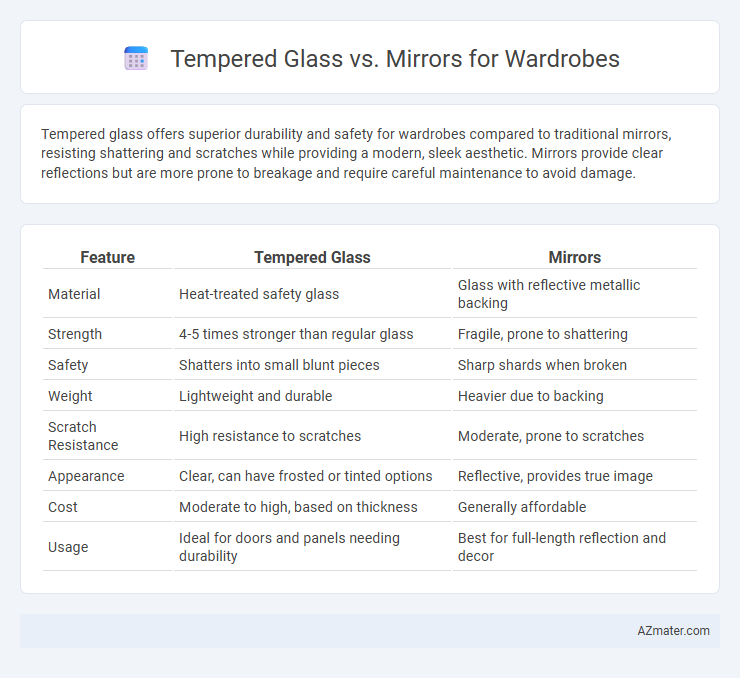Tempered glass offers superior durability and safety for wardrobes compared to traditional mirrors, resisting shattering and scratches while providing a modern, sleek aesthetic. Mirrors provide clear reflections but are more prone to breakage and require careful maintenance to avoid damage.
Table of Comparison
| Feature | Tempered Glass | Mirrors |
|---|---|---|
| Material | Heat-treated safety glass | Glass with reflective metallic backing |
| Strength | 4-5 times stronger than regular glass | Fragile, prone to shattering |
| Safety | Shatters into small blunt pieces | Sharp shards when broken |
| Weight | Lightweight and durable | Heavier due to backing |
| Scratch Resistance | High resistance to scratches | Moderate, prone to scratches |
| Appearance | Clear, can have frosted or tinted options | Reflective, provides true image |
| Cost | Moderate to high, based on thickness | Generally affordable |
| Usage | Ideal for doors and panels needing durability | Best for full-length reflection and decor |
Introduction to Wardrobe Material Options
Wardrobe material options prominently include tempered glass and mirrors, each offering unique aesthetic and functional advantages. Tempered glass is highly durable, resistant to impact and scratches, making it suitable for long-lasting wardrobe doors and panels. Mirrors enhance space perception and light reflection, creating an illusion of a larger room while providing practical use for dressing and grooming.
What is Tempered Glass?
Tempered glass is a type of safety glass processed by controlled thermal or chemical treatments to increase its strength compared to normal glass. It is designed to shatter into small, blunt pieces rather than sharp shards, reducing the risk of injury, making it an ideal choice for wardrobe doors. Unlike mirrors, tempered glass offers enhanced durability and resistance to heat and impact, ensuring long-term safety and functionality in home interiors.
What are Mirrors in Wardrobes?
Mirrors in wardrobes serve as reflective surfaces integrated into doors or panels, enhancing visual space and functionality in bedrooms. Tempered glass mirrors offer increased durability and safety compared to standard mirrors, resisting shattering and reducing injury risks. These glass mirrors also provide a sleek, modern aesthetic while allowing natural light to bounce throughout the room.
Aesthetic Appeal: Tempered Glass vs Mirrors
Tempered glass offers a sleek, modern aesthetic with a smooth, reflective surface that enhances light diffusion and creates a spacious feel in wardrobe design. Mirrors provide a classic, multifunctional design element that not only reflects surroundings but also adds depth and dimension, making rooms appear larger and brighter. Both materials elevate wardrobe aesthetics, but tempered glass emphasizes contemporary minimalism while mirrors highlight practical elegance.
Safety and Durability Comparison
Tempered glass offers superior safety for wardrobes due to its ability to shatter into small, blunt pieces instead of sharp shards, reducing injury risk compared to traditional mirrors. In terms of durability, tempered glass is more resistant to impacts, scratches, and thermal stress, making it less prone to cracking and breaking under everyday use. Mirrors, while providing clear reflections, generally lack the enhanced safety features and sturdy composition of tempered glass, making tempered glass the safer and more durable option for wardrobe doors.
Maintenance and Cleaning Requirements
Tempered glass used in wardrobes offers superior resistance to scratches and stains, making it easier to maintain with just regular wiping using a soft, damp cloth and mild detergent. Mirrors require more frequent cleaning to avoid smudges and fingerprints, often needing glass cleaners and lint-free cloths to maintain their clarity and shine. Both materials benefit from avoiding abrasive cleaners, but tempered glass's durability reduces the risk of damage during routine cleaning.
Cost Differences: Tempered Glass vs Mirrors
Tempered glass for wardrobes generally costs more than traditional mirrors due to its durability, safety features, and manufacturing process. While mirrors offer a more budget-friendly option, tempered glass provides increased resistance to impact and shattering, justifying the higher price point in the long term. Homeowners seeking a balance between aesthetics and safety often consider tempered glass despite its initial cost difference compared to mirrors.
Space Enhancement: Reflective Qualities
Tempered glass and mirrors both enhance wardrobe space through reflective qualities, but mirrors offer superior clarity and true-to-life reflection that visually expand the room. Tempered glass, while durable and shatter-resistant, provides a subtler reflection that can soften light and create a more diffused sense of openness. Choosing mirrors maximizes spatial perception by reflecting both natural and artificial light, making small wardrobes appear larger and brighter.
Customization and Design Flexibility
Tempered glass offers superior customization options with various finishes such as frosted, tinted, or textured surfaces, enhancing design flexibility for wardrobes. Mirrors provide classic reflection benefits but can be limited in shape and edge design compared to versatile tempered glass panels. Choosing tempered glass allows for unique patterns, colors, and safety features, making it ideal for bespoke wardrobe interiors and exteriors.
Which is Better for Your Wardrobe?
Tempered glass offers superior durability and safety for wardrobes due to its shatter-resistant properties, making it ideal for households with children or high-traffic areas. Mirrors provide a reflective surface that enhances room brightness and can create the illusion of more space, but they are more fragile and prone to breaks and scratches. Choosing tempered glass or mirrors depends on your priorities for safety, aesthetics, and maintenance in your wardrobe design.

Infographic: Tempered glass vs Mirrors for Wardrobe
 azmater.com
azmater.com